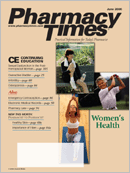Publication
Article
Pharmacy Times
Overactive Bladder: Putting the Patient in Control
Up to 17% of the American population suffers from overactive bladder (OAB), with elders disproportionately affected.1,2 Its symptoms?urgency with or without incontinence, frequency, and nocturia3?may occur alone or in combination.4 Up to half of women have experienced urinary incontinence at some time in their lives.5 Like many chronic problems, OAB often is associated with poor overall health, declining quality of life, social isolation, and mental health concerns.5
Patients often are reluctant to discuss OAB with their clinician (only 13% to 51% of incontinent women raise the issue in regular visits5). If they mention it but perceive that the clinician dismisses it, most patients are too embarrassed to mention it again.6 Some patients never raise the concern at all (Table 1). Failure to address OAB in the elderly is especially troublesome: it increases the likelihood of admission to a nursing home,7 the risk of falls,8 and a risk of suicide that is higher than that associated with other more common medical illnesses such as asthma, cardiac disease, or chronic obstructive pulmonary disease.9
Reducing or eliminating incontinence is a reasonable treatment goal. Bladder training, timed/prompted voiding, pelvic muscle exercises, and biofeedback are the first interventions usually employed. Behavioral therapy focuses on changing the patient's voiding habits and teaching skills for preventing urine loss. Should these interventions fail, drug therapy is considered.
Available Treatment
Immediate-release (IR) oxybutynin has been the gold standard for OAB since the 1970s.4 Other agents?such as propantheline, hyoscyamine, and imipramine?have largely been abandoned for OAB treatment. Other antimuscarinic drugs continue to be first-line treatment,4,10,11 but side effects often limit their use.
Newer drugs, formulations, and delivery systems attempt to improve the tolerability of this drug class.12-14 Combining drug therapy, lifestyle modification, and/or behavioral therapy can help some patients achieve total dryness or balance efficacy and side effects. Although the extended-release (ER) or long-acting formulations have been associated with a lower adverse-event burden, the immediate-release doses are often drugs of choice for simple nocturia. Table 2 highlights FDA-approved drugs for OAB.
All of the antimuscarinic drugs have potential anticholinergic side effects: dry mouth, constipation, sedation, impaired or disturbed cognitive function, tachycardia, and blurred vision. Of these effects, dry mouth and constipation are the most common. Antimuscarinic drugs are contraindicated in patients with narrowangle glaucoma, urinary retention, or gastric retention, and they should be used with caution in elderly patients with gastroesophageal reflux, constipation, memory loss, or dementia.15,16
Individualized Dosing
Flexible dosing is the latest OAB treatment strategy. It involves having patients adjust the antimuscarinic dose independently or after calling the prescriber in increments at preplanned intervals, until patients (1) achieve complete continence, (2) experience side effects they cannot tolerate, or (3) reach the agent's maximum dose.
Numerous studies have examined this approach with darifenacin (7.5-15 mg),17 solifenacin (5-10 mg),17,18 and oxybutynin ER and/or IR.12,19,20 These studies have used various comparators (ie, placebo, ER or IR formulations of the same drug, or another antimuscarinic). Most patients reported significant improvement in OAB symptomatology?with up to 70% reporting fewer incontinence episodes?and more than 40% achieved complete dryness. Experts consider this approach highly efficacious, with greater numbers of patients reporting complete dryness than when fixed dosing is used.
Dry mouth was the adverse event reported most frequently. It increased incrementally with increasing doses in the flexible-dosing studies; nevertheless, few patients discontinued treatment. Less than one quarter of patients graded their dry mouth as moderate to severe.12,17-20 It seems that patients will tolerate some dry mouth (from 50% to 70% of patients chose to increase their dose) to reach the optimal balance between continence and side effects.
Flexible dosing requires incontinent patients to be partners and decision makers in their care. It is imperative that prescribers discuss treatment goals with patients and that they start with a low dose of antimuscarinic. The appropriate amount of dosage increase and time intervals between the increases must be clear, and there can be no ambiguity in the patient's understanding. Prescribers should ask patients to use a diary to track progress. They should direct patients to call them if expectations are not met, at which time they should discuss the possibility of increasing the dose.
Summary
It is time for OAB to come out of the closet and to be addressed and treated. A larger selection of dosage forms than ever before is currently available. Physician-initiated, patient-managed dose adjustment is a successful strategy for addressing OAB. It allows patients some control and reduces unnecessary physician visits.
Ms. Wick is a senior clinical research pharmacist at the National Cancer Institute, National Institutes of Health. Dr. Zanni is a health-systems consultant and a psychologist based in Alexandria, Va. The views expressed are those of the authors and not those of any government agency.
For a list of references, send a stamped, self-addressed envelope to: References Department, Attn. A. Stahl, Pharmacy Times, 241 Forsgate Drive, Jamesburg, NJ 08831; or send an e-mail request to: [email protected].

Newsletter
Stay informed on drug updates, treatment guidelines, and pharmacy practice trends—subscribe to Pharmacy Times for weekly clinical insights.






